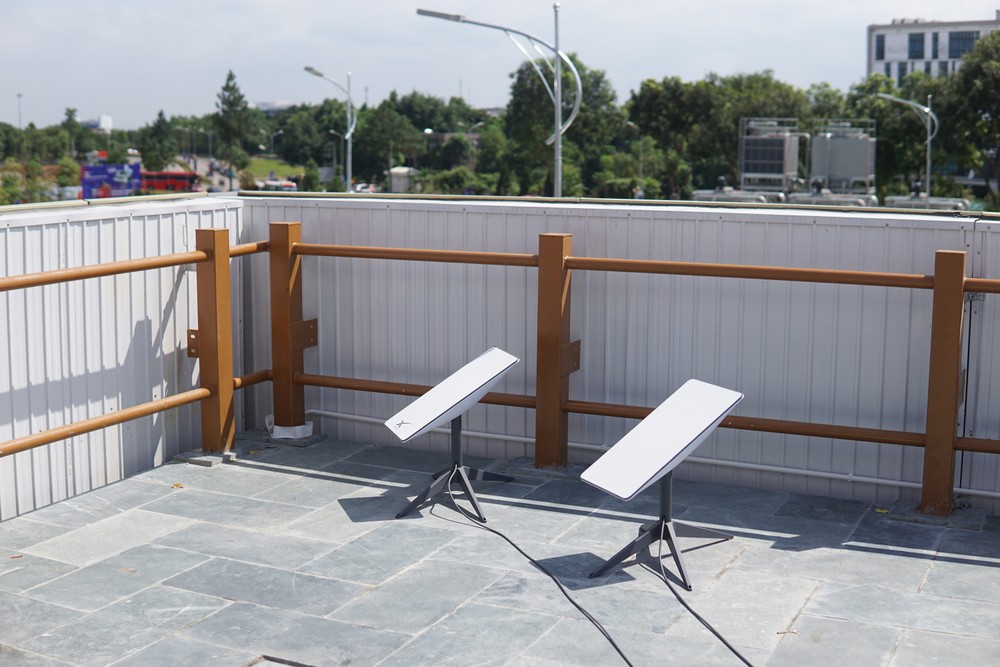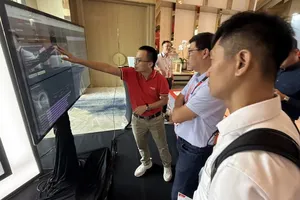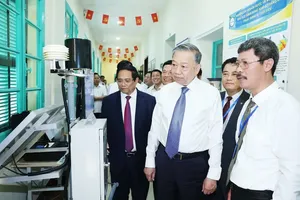Starlink is a satellite internet network developed by SpaceX, a U.S.-based corporation founded by billionaire Elon Musk. Recent developments suggest that Starlink's services may soon be available in Vietnam, as the company takes steps toward expanding its global coverage.

During a meeting with Deputy Prime Minister Nguyen Chi Dung in early April 2025, Minister of Science and Technology Nguyen Manh Hung outlined two primary objectives for the year that are to enhance mobile internet speeds through the upgrade and expansion of the 5G network and to pilot the Starlink satellite internet service.
At this meeting, Director of the Telecommunications Department of the Ministry of Science and Technology Nguyen Thanh Chung said that he is working with SpaceX Corporation to support the enterprise in completing the next steps before it can operate in Vietnam. In particular, SpaceX will soon establish a business and install ground gateway stations in Vietnam. This station is for Starlink satellite internet connection in Vietnam. Also in April 2025, the Government granted SpaceX Corporation a license to conduct a controlled pilot investment in the business of satellite telecommunications network services using low-earth orbit satellite technology in Vietnam (Starlink service).
This marks a significant development for Vietnam’s broadband internet market. Under a recent government decision, SpaceX has been granted conditional approval to pilot its satellite internet service for a five-year period, ending no later than January 1, 2031. The pilot program allows a maximum of 600,000 subscribers and must meet stringent national defense and security requirements.
One key condition mandates that SpaceX establish a gateway station within Vietnam. All internet traffic generated by satellite subscribers on Vietnamese territory must be routed through this gateway and integrated into the domestic public telecommunications network. Additionally, user data and information must be stored within Vietnam, and the service must comply with regulations aimed at preventing the spread of malware, cyberattacks, and harmful content.
Current activities indicate that SpaceX’s first gateway station may become operational as early as late May or June in Da Nang City. Vietnam is also considering permitting the company to install 10 to 15 such stations across the country.
Starlink is a satellite internet project developed by SpaceX since 2019. This system has more than 6,000 low-orbit satellites, providing internet connection to many areas around the world, especially where traditional network infrastructure is limited. SpaceX began providing Starlink service in the US in October 2020.
Currently, this service caters to nearly 3 million customers across over 100 countries worldwide. Starlink's average pricing is set at US$99 per month (approximately VND2.4 million). Experts believe that the introduction of Starlink will facilitate digital transformation and help bridge the digital divide in Vietnam. However, to maximize effectiveness, it is essential for SpaceX to collaborate closely with local telecommunications companies and invest in infrastructure and supply chains, as Starlink represents the best solution for areas with poor signal coverage in remote regions where 4G, 5G, and fiber optic networks are unavailable in Vietnam.
In the coming time, Starlink is expected to offer high-speed internet access in remote locations and islands, where Vietnamese telecom operators face challenges in establishing fiber optic and 4G, 5G networks. Customers in remote locations and islands can choose Starlink instead of using traditional solutions such as fiber optic cables, while 4G and 5G mobile services have weak coverage.
A representative of a network operator believed that Starlink cannot completely replace fiber optic cables or mobile networks because it still has higher latency and depends on weather conditions. Starlink will create a new competitive driving force for network operators to quickly complete their telecommunications infrastructure, bring fiber optic cables to households and promote 5G coverage nationwide.
According to statistics from the Department of Telecommunications under the Ministry of Science and Technology, Vietnam's mobile network currently covers 99.8 percent of the population. However, it only covers about 58 percent of the mainland area and 14.5 percent of the territory including the sea area. Along with that, there are currently 17 percent of Vietnamese households that do not use fiber optic services, many of which are in remote areas.
Untill now, all three major mobile networks in Vietnam, Viettel, VNPT and MobiFone, have officially provided 5G services. Regarding subscribers, in early March, Viettel said it had 5.5 million 5G network users, while VNPT VinaPhone reached more than 3 million. Meanwhile, MobiFone provided 5G since the end of March and said it reached more than 2.5 million users after one month of deployment.
Starlink's satellite internet utilizes low-earth orbit (LEO) satellites, which operate at altitudes ranging from 600 to 2,000 kilometers above the Earth's surface. This satellite system is being developed by the United States and several countries, including China, India, and the European Union, to address the challenges of high-speed internet bandwidth with low latency, independent of terrestrial infrastructure. In Vietnam, VNPT currently owns and operates two telecommunications satellites under the Vinasat program, both positioned in geostationary orbit (GEO) at approximately 36,000 kilometers. Vinasat-1 was launched in 2008 and is designed to last until 2028, while Vinasat-2, launched in 2012, continues to function normally. These satellites provide traditional telecommunications services with limited bandwidth, primarily for television broadcasting, basic phone services, and average-speed internet connections.
According to plans, Vietnam will launch the LOTUSat-1 satellite in 2025 as part of the project 'Disaster Prevention and Climate Change Adaptation Using Earth Observation Satellites,' a collaboration between the Vietnam Space Center and Japan. General Director Pham Anh Tuan of the Vietnam National Space Center (Vietnam Academy of Science and Technology) stated that Vietnam could master this technology, but it would only be effective if multiple satellites are manufactured and utilized globally. A system like Starlink requires thousands of LEO satellites. Vietnam lacks its own launch vehicles and must rely on rentals, which will increase investment costs. In other words, significant investment is necessary to develop such a satellite system.
























